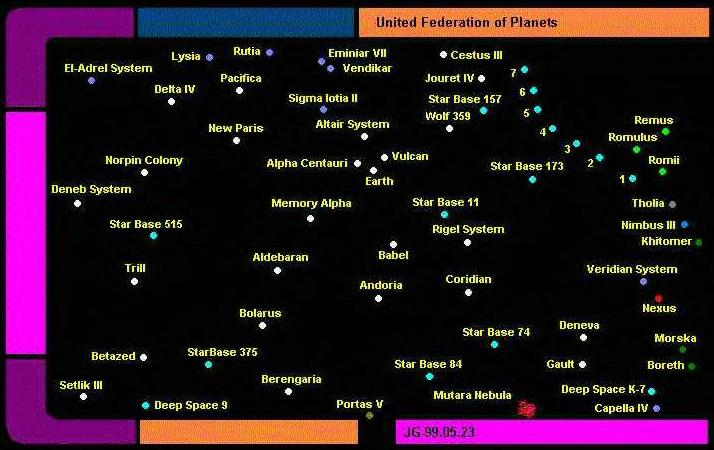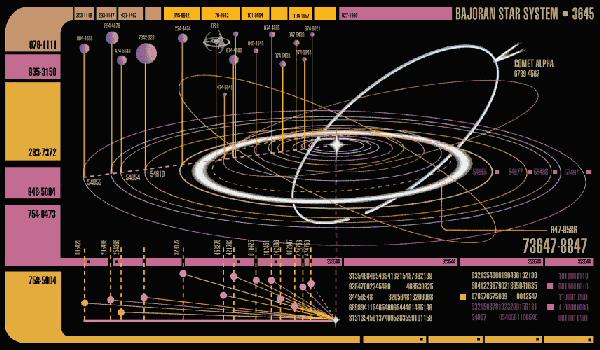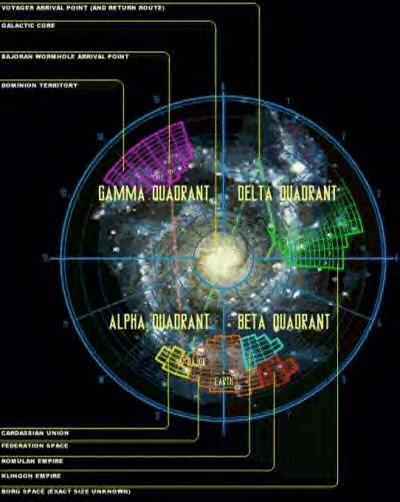 |
 |
 |
 |
 |
| SFEF MAPS PAGE |
 |
 |
 |
| VOYAGER ARRIVAL POINT AND RETURN |
| GALATIC CORE |
| BAJORAN WORMHOLE ARRIVAL POINT |
| DOMINION TERRITORY |
| CARDISSIAN UNION |
| FEDERATION SPACE |
| ROMULAN EMPIRE |
| KLINGON EMPIRE |
| KNOWN BORG SPACE |
| SPACE FLEET'S ELITE FORCES |
| Deep Space 11 |

|
| PLANETARY CLASSES CLASS D: A small rocky planetoid with an airless surface - essentially a great rock in space. The class D planetoid Regula was chosen as the site for the second phase of the Genesis project, and the Starfleet corps of engineers spent ten months in space suits tunnelling out a complex under the surface to facilitate the project. The second phase was a success, creating a cavern several miles across in the planetoid. Class D objects are not habitable by Human life forms without extensive life support facilities. � � CLASS H: Generally extremely dry, class H planets are marginally habitable. Tau Cygna V is a good example of a habitable class H planet. With an atmosphere capable of supporting Human life, the planet was bathed in levels of hyperonic radiation thought lethal to Human life. Nevertheless, when a colony vessel crash-landed on the planet in the 2270s the colonists were eventually able to adapt to the radiation and survive. Class H planets are also suitable for colonization by the Sheliak. � � � � CLASS J: Class J planets are gas giants. Largely composed of Hydrogen and Helium, they have turbulent atmospheres with wind speeds in excess of 10,000 kilometres per hour. Jupiter and Saturn in the Sol system are examples of class J planets. Both planets have extensive collections of moons, while Saturn also has a major ring system comprising many hundreds of individual rings. There are several Starfleet facilities located near the planets, including the Jupiter station and a Starfleet Academy training range. � � � CLASS K: Class K planets have gravity fields which are suitable for Humanoid life, but are otherwise uninhabitable. They are only suitable for habitation with the use of pressurized domes or underground habitats using life support systems. Planet Mudd was class K and at one time sustained a sophisticated civilization. This died out some time ago, leaving advanced robot technology behind which was utilized by Harcourt Fenton Mudd in order to briefly capture the Starship Enterprise. � � � CLASS L: These are small rocky worlds with an oxygen-argon atmosphere. They are sometimes capable of supporting life, but this tends to be limited to plant life only. Class L planets tend to have a high concentration of atmospheric carbon dioxide. In 2373 a Starfleet runabout containing two personnel from the Deep Space Nine station crash-landed on a class L planet. In 2340 the class L planet Indri VIII was discovered by the Federation. It became the subject of a scientific research project by several governments in 2369 when it became apparent that an ancient species had seeded many planets, including this one, with genetic codes designed to direct evolution on the planet towards a Humanoid form. The codes apparently failed to perform this function on Indri VIII. In order to prevent anybody from recovering samples from the planet, a Klingon vessel destroyed the entire biosphere with a plasma reaction. Voyager encountered a class L planet in the Delta Quadrant which had a flourishing Human civilization upon it, descended from Humans abducted from Earth in the 20th century. Other class L's are not so habitable, however - in 2374 the crew of the USS Defiant raced to rescue a Starfleet officer from a class L planet whose atmosphere was so inhospitable that she required regular doses of tri-ox compound. The attempt was unsuccessful. � � CLASS M: Class M is the Federation designation for planets which have similar environmental conditions to those on Earth. They are approximately 12,000 kilometres in diameter and have temperatures which allow liquid water to exist on large parts of the surface. The atmospheres tend to be an oxygen-nitrogen mix, highly supportive of organic life. Starfleet tends to focus much of its effort on class M planets, since these are the ones most commonly inhabited by Humanoid life. � � � CLASS Y: Also known as a Demon class planet, these are the most inhospitable worlds known to the Federation. The surface temperatures are at least 500 Klevin, and the atmosphere is highly toxic and corrosive. Worst of all, Demon class planets have very high levels of thermionic radiation which make it dangerous for a vessel even to enter orbit. Voyager encountered a Demon class planet in 2374 which had extensive deposits of Deuterium on the surface contained within some form of liquid metal. The ship, which was very low on fuel at the time, landed on the planet n order to mine supplies. The crew were surprised to discover that the liquid metal was in fact a life form. |
| "Space, the Final Frontier" The Federation, although a large unification of planets, plays such an insignificant part in the overall operation of the galaxy known as the Milky Way. The Star Trek galaxy is divided into four quadrants; the Alpha, Beta, Delta and Gamma Quadrant. The United Federation of Planets is primarily located in the Alpha Quadrant with a few distant worlds falling just outside into the Beta quadrant. Earth currently exists in the Alpha quadrant. Below is a description of some of the more important planets or areas of space for each quadrant... The Alpha Quadrant: This area of space contains the most part of the Federation member planets, including Earth. Deep Space Nine and Bajor currently exist in this quadrant along with Vulcan. Even in the 24th Century, most of this region remains unexplored! The Beta Quadrant: This area of space also remains mostly unexplored and contains the Klingon and Romulan Star Empire.This area also contains some member planets of the Federation. The Delta Quadrant: Virtually unexplored, the Delta quadrant is so far from the Federation that no Starships can travel out that far. Although brief encounters with this quadrant have occurred due to alien intervention, the only Federation Starship in the area is the starship Voyager. Also thrown into this area of space due to an alien force, the ship has seventy years travel in front of her until it reaches the Federation. The Borg homeworld can also be found here along with many other planets encountered by Voyager. The Gamma Quadrant: Another area of the Milky Way galaxy which remains for the most part unexplored. The discovery of the stable artificial wormhole in Bajoran space which links the Alpha to the Gamma quadrant has meant that exploration of this part of the galaxy is now possible. Planets in this area of space include the founders homeworld and many more. |
|
|
|
|
| Risa |